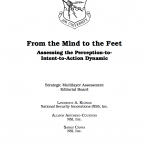From the Mind to the Feet: Assessing the Perception-to-Intent-to-Action Dynamic

From the Mind to the Feet: Assessing the Perception-to-Intent-to-Action Dynamic
Author | Editor: Kuznar, L., Astorino-Courtois, A. & Canna, S. (NSI, Inc).
The purpose of From the Mind to the Feet is to open a much deeper dialogue about gauging intent than currently exists ei- ther in operational or academic arenas. It is intended to serve military and civilian defense leaders, deterrence and policy planners, and practitioners with a review of the basic concepts and state-of-the-art understanding of intent. It is organized into two sections: operational and academic perspectives on intent.
Operational Perspective: Basic Issues in Gauging Intent
The first section of this volume consists of four operational perspectives on intent. Kathleen Kiernan and Daniel J. Mabrey offer an enlightening description of law enforcement “street-craft” and explain how police methods of assessing an individual’s intent to offend can inform counterterrorist operations.
Harry Foster discusses the ways military planners typically assess the intent of state or nonstate leaders and then offers what he calls an “effects-based thinking” framework for measuring intent. Foster argues that this effects-based thinking combined with a betting methodology offers the best analytic framework for melding the analyst’s intuition (i.e., the art) with analytics to gauge intent.
Gary Schaub, Jr., widens the aperture to focus on how to gauge the intent of groups and large collectives such as nation-state and nonstate actors in the context of strategic deterrence. Schaub argues that a process to infer adversary intent on a continuous basis is needed so that a serviceable product is available to assist both in routine and crisis planning. He posits analysis of competing hypotheses as one method of achieving this goal that encourages debate and critical thinking about the adversary to prevent the typical intelligence errors of mirror imaging or groupthink.
Finally, John Bodnar outlines a new way of thinking about adversaries—and our relationship to them—in the twenty-first century.
Academic Perspective: Theory and Research in Gauging Intent
The second section of this volume consists of perspectives on intent that represent research and theoretical work in seven academic disciplines: anthropology, social psychology, international politics, social cognitive neuroscience, survey science, communications, and decision science.
In the first piece in this section, Lawrence Kuznar provides a comprehensive review of basic motivating factors recognized by anthropologists that help explain intent, including structuralism, interpretivism/symbolic anthropology, postmodernism, culture and personality, human behavioral ecology, and discourse analysis. It provides insight on intent as derived from socially shared systems of meaning and ideology.
Margaret Hermann concludes that learning how policy makers view what is happening to them is critical to understanding how governments are likely to act. With our unprecedented access to policy makers’ perspectives through 24-hour news cycles, new ways to measure and interpret these perspectives are being developed. Hermann’s assertions are tested by a case study in the following chapter.
Based on international relations research, Keren Yarhi-Milo provides analytic support for what we have always suspected: intelligence analysts and decision makers do not view the world or think about it in the same ways. Yarhi-Milo uses three test cases: British assessments of Nazi intentions prior to World War II, the Carter administration’s assessments of Soviet intentions, and the Reagan administration’s assessment of Soviet intentions in the final years of the Cold War.
Neuroscientists are actively unlocking the inner workings of the brain and revealing how goal-oriented, deliberative behavior interacts with emotive impulses to generate intentional behavior. In companion pieces, social neuropsychologists Sabrina Pagano and Abigail Chapman shed light on the latest in brain studies and the possible future applications of insights gained from neuropsychology for estimating and capturing an individual’s intent to act in a certain way.
Tom Rieger offers empirical evidence that large-scale instability-based violence and ideologically based violence are driven by different factors with different purposes. Iraq is used as an example to explain extremist violence and to illustrate how it is possible to win a war and lose the peace.
Representing social communication and messaging, Toby Bolsen discusses information-framing research and the gaps in the literature regarding the links between manipulations of perceptions and attitudes (framing) and short- and long-term behavior.
Finally, theories of intent abound, but the most difficult task is the measurement and assessment of this intangible. Elisa Bienenstock and Allison Astorino-Courtois address some contemporary efforts in actually measuring intent and propose a backward induction method for honing in on intent based on behavioral “probes” identified through decision analyses.
Contributing Authors
Elisa Jayne Bienenstock (NSI), John W. Bodnar (SAIC), Toby Bolsen (GSU), Abigail Chapman (NSI), Robert Elder (GMU), Harry A. Foster (Air University), Margaret G. Hermann (Syracuse U), Kathleen L. Kiernan (Kiernan Group), Daniel J. Mabrey (U of New Haven), Sabrina Pagano (NSI), Tom Rieger (NSI), Gary Schaub (Air War College), Keren Yarhi-Milo (Princeton)

Comments